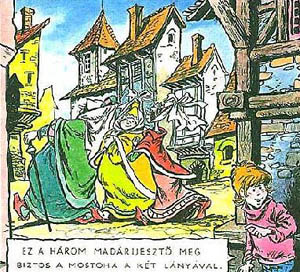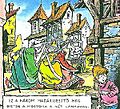Lívia Rusz facts for kids
Quick facts for kids Lívia Rusz |
|
|---|---|
| Born | September 28, 1930 Cluj |
| Died | February 25, 2020 (aged 89) Bucharest |
| Nationality | Dual: Romanian and Hungarian |
| Area(s) | Artist |
|
Notable works
|
Mac, Cocofifi, Dan Buzdugan, Csipike, Miskati közbelép |
Lívia Rusz (born September 28, 1930 – died February 25, 2020) was a talented artist from Romania and Hungary. She was famous for her amazing illustrations, comic strips, and comic books. During a time when Romania was under communist rule, Lívia Rusz became one of the most well-known artists in these fields.
She created popular comics for children, like Mac and Cocofifi. Later, she became a main illustrator for the Editura Ion Creangă publishing house. She drew pictures for many important books, including a version of Ion Creangă's Childhood Memories. She also illustrated the very first Romanian edition of J. R. R. Tolkien's The Hobbit.
Lívia Rusz was part of the Hungarian-Romanian community. In 1987, she moved to Budapest, Hungary, to escape political difficulties in Romania. She continued her artistic work there and became a recognized artist in the Hungarian comics world.
Contents
Early Life and Artistic Journey
Growing Up in Cluj
Lívia Rusz was born in Cluj (also known as Kolozsvár). She grew up in a family with both Hungarian and Romanian roots. She remembered her school as a special place that taught her to respect traditions and cultural values. This helped her appreciate her own identity while also respecting others.
Learning to Be an Artist
Lívia's father, Liviu, worked for the Romanian Railways. He was also an amateur artist and a skilled calligrapher. He even took lessons from a painter named Sándor Szopos. Lívia loved art too. She copied her father's paintings and learned to use watercolors. She even joined a class taught by Szopos.
After primary school, Lívia went to high school in Cluj. Her artistic skills caught the eye of painter Zoltán Kovács. He recommended her for the Cluj Art Institute. She finished her studies there in 1955. Lívia felt lucky to have been taught by Kovács, who she saw as a great artist. She described herself as a "conservative" artist, meaning she stuck to her style and didn't change it with every new trend. After graduating, she worked as an assistant at the Institute for three years.
Creating Comics and Illustrations
First Steps in Children's Magazines
Lívia Rusz began working with magazines for children. Over time, her comic art was inspired by Jean Cézard, a French artist known for Arthur le fantôme justicier. He was one of the few foreign cartoonists known in Romania back then.
Her first job was with Napsugár, a magazine in Hungarian. There, she met writer Sándor Fodor. They worked together on a series of books called Csipike (known as Piticul Cipi in Romanian). This work got her noticed by Lucia Olteanu, an editor for Luminiţa, a Romanian magazine in Bucharest.
Popular Comics for Kids
Lívia accepted the offer to work with Luminiţa. With Olteanu, she created the comic strips Răţoiul Mac ("Mac the Duck") and Cocofifi. These comics became very popular with young readers. She also started working with other youth magazines like Arici Pogonici and Cutezătorii.
Some of her other comic projects included a version of L. Frank Baum's The Wonderful Wizard of Oz. She also drew Maimuţa Kio ("Kio the Monkey") and Dan Buzdugan ("Dan the Mace"). Dan Buzdugan was a medieval fantasy series with a more realistic drawing style, different from her other works.
Illustrating Famous Books
Lívia Rusz also started working as an illustrator, mostly creating cover art for publishing houses like Editura Ion Creangă. Her work impressed Tiberiu Utan, a writer and manager at Ion Creangă. Lívia then became a regular artist for the company.
At Editura Ion Creangă, she illustrated books like Wilhelm Hauff's Märchen (called Basme in Romanian). She also drew pictures for classic Romanian children's books, such as Nicolae Constantin Batzaria's Poveşti de aur ("Golden Stories") and Ion Creangă's fairy tales and Childhood Memories.
The Hobbit's First Romanian Illustrator
During this time, Lívia Rusz became the first Romanian artist to illustrate J. R. R. Tolkien's work. She drew pictures for The Hobbit in its first Romanian edition in 1975. When she worked on this project, she couldn't easily find other artists' drawings of hobbits, Elves, or Orcs. This was because foreign books were hard to find in Romania. So, her drawings came mostly from her own amazing imagination.
Moving to Hungary
In 1987, Lívia Rusz decided to leave Romania. This was two years before the December Revolution changed the government. At that time, the government made things difficult for some of Romania's ethnic minorities, including Hungarians. A writer named György Györfi-Deák said that Lívia Rusz was "harassed" by officials.
After a short stay in Germany, Lívia settled in Budapest, Hungary. She continued her work there and became an important artist in the Hungarian comic school. She created albums like Miskati közbelép ("Miskati Intervenes"). She described this move as difficult, saying it was like moving a plant to a new pot. But she kept working, which showed she was still full of life.
Lívia Rusz's Impact on Art
A Leading Artist in Romania
In Romania, Lívia Rusz was one of the few female comic artists. She is seen as a very important contributor to the art forms she worked on. György Györfi-Deák wrote that Lívia Rusz led people through "an enchanted universe" with her unique and graceful drawings.
Artist Arina Stonescu noted Lívia Rusz as one of the three main illustrators for Editura Ion Creangă. Her drawings for Childhood Memories were especially praised. Györfi-Deák called the book "legendary." Arina Stonescu even imagined Ion Creangă's world filled with Lívia Rusz's characters in traditional Romanian clothes.
Recognition and Influence
Comics historian Dodo Niţă called Lívia Rusz "the greatest creator of comic strips in Romania." He ranked her comics Mac and Cocofifi as second best in Romanian comics history.
Even though the government during her time preferred animation for its messages, Lívia Rusz and Eugen Taru were among the few who still made comics that reached many people. After 1989, interest in her work grew again. Her art was featured in important books about comics. She was also a special guest at the Romanian-Hungarian Comics Salon in Budapest.
Dodo Niţă and Ferenc Kiss wrote the first special book about Lívia Rusz in 2009. It included tributes from fans like historian Adrian Cioroianu and writer Mircea Opriţă. Opriţă said that an artist who draws for children needs not only talent but also "an outstanding soul."
International Reach
Lívia Rusz's work became known outside Hungary and Romania in the 1970s and 1980s. Her comics Mac and Cocofifi were translated into English, German, Russian, and Spanish. Versions of her books were published in countries like Hungary, East Germany, and Cuba.
While her The Hobbit illustrations were very popular in Romania, they became known internationally only after 1989. This happened when her drawings were republished by Douglas A. Anderson.
Images for kids



